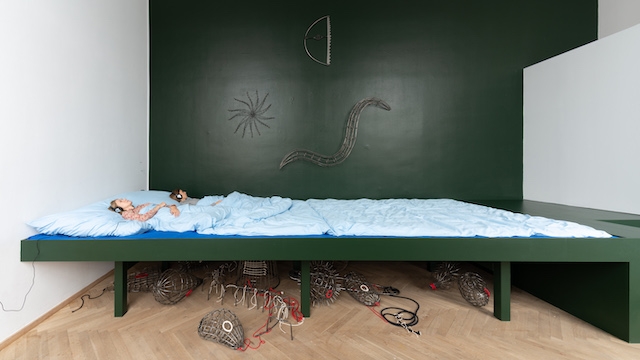Recalling early-twentieth-century avant-garde practice and influenced by the Surrealism of postwar Czech film and theatre, Eva Kot’átková’s work wraps abstract sculpture in psychological narratives to articulate social breakdown on behalf of the voiceless and disenfranchised. Here, visitors first encounter the eponymous Confessions of the Piping System (2019), a low, horizontal metal grid-structure festooned with fragments of images, sculptures and short texts on protest-sign placards. This is further activated at times by performers, who move on their backs within its restricted space while reciting stories, real and fictional, selected, commissioned or written by the artist. Among these are unsettling tales of the infirm and disadvantaged; tragic yet objective descriptions of precarious lives cut off from care and assistance. Penetrating the sculpture’s metal grid – which reads as both structure of orientation and repressive system – the placards display short quotations from the stories such as, ‘I speak for the sick who cannot afford to be sick’. The contrast between these fragile messages and the usual display of power and solidarity typically expressed by protest slogans is an empowering gesture. While the oppressive forces targeted are left unnamed, it’s easy to make a connection to the pressures of today’s gig economy, the ongoing social havoc of neoliberalism and the collapse of social structures Kot’átková experienced while growing up in post-Communist Czechoslovakia.
In the second room, an inset vitrine painted spectral red presents hundreds of images and fragments of text cut from books and newspapers – among them images of autonomous limbs, children at play, birds, reptiles, anatomical diagrams – each held in place by white string. Titled Error (2019), the collection materialises an alternative system of classification, questioning established taxonomies and defining the world – and the artist’s collage-based approach – as political. Also here is Place for Speaking Out, Place for Making the Private Public (2018), a vertical cage scaled to the dimensions of a single person. This work, originally situated in a public square, emphasises Kot’átková’s desire to give a public voice to people who need it by offering a protected, safe yet paradoxically restraining space to talk from and through.
Participation and the act of cutting-out come together in Room for Restoring Empathy (2019), comprising the remnants of a children’s workshop about ‘how to speak through objects or personal items’, in which difficult emotions were dealt with by snipping and sewing clothing. An oversize pair of scissors leaning against the wall stands in for how cutting, collage and editing might be positive ways to deal with negative psychologies. Borrowing from the clinical method of psychodrama, speaking ‘through’ an object is central to Kot’átková’s work, both providing an unspoken language for the voiceless and playfully instrumentalising the nonverbal communication of visual art and sculpture itself.
An oversize bed occupies the final room: visitors can crawl into it and listen to children’s dreams recounted via headphones. The scale ensures that anyone in the bed feels small, and the nature of the recounted dreams give a further sense of powerlessness and dysfunction. Rooted in daydreaming but also anxiety and politics, the brightly lit installation is titled Dream Machine is Asleep (2018). Kot’átková has described the imaginative power of dreams not as an escape but as an essential step in the transformation of reality. Her work is powerful not only because it allows victims of the systemic and often hidden brutality of our present moment to articulate their situations, but also because it offers hopeful tools of resistance, with a ‘light’ visual vocabulary that is playful, colourful and accessible – so that once the message of her mediating devices sinks in, your perception cannot but be transformed.
Eva Kot’átková, Confessions of the Piping System, Kunsthal Charlottenborg, Copenhagen, 21 September 2019 – 16 February 2020
From the March 2020 issue of ArtReview
